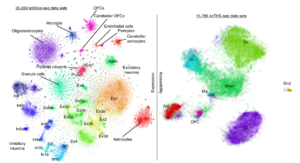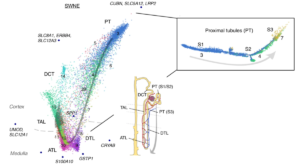Mapping human cell types
Using single cell technologies to generate quantitative maps of healthy and diseased human cell types

Mapping the human brain
As part of the NIH Brain Initiative, we are creating maps of the human brain by profiling single cell gene expression and chromatin accessibility. Our latest project involved a cross species comparison of gene expression and gene regulation in the human and marmoset motor cortexes. We have also generated single cell gene expression and gene regulation maps of the human visual cortex and cerebellum and a gene expression map of six different Brodman's Areas of the cerebral cortex.

Mapping the human kidney
With the Kidney Precision Medicine Project and HuBMAP, we are creating maps of the human kidney by profiling single cell gene expression, chromatin accessibility, multi-omics, and spatial gene expression. We have profiled the single cell gene expression of human kidney development as well as of adult kidneys to better understand the landscape of kidney cell states. We are currently working on profiling both single cell gene expression and chromatin accessibility of healthy and diseased kidney cells to understand the shifts in expression and gene regulation that occur during disease. We are also interested in profiling the spatial expression of kidney cells to better understand the structural organization of the kidney and how this structural organization might change in kidney disease.
Mapping the human lung
With the help of CZI and HuBMAP, we are mapping out the gene expression and gene regulation of both the developing and adult human lungs. We are interested in better understanding lung development, as well as the cellular landscape of the adult lung. With this understanding, we hope to unravel the biology behind lung diseases.
Mapping the heterogeneity of pediatric tumors
As part of the Human Tumor Atlas Network, we are mapping out the gene expression and gene regulation of pediatric gliomas and neuroblastomas. Cancer tumors are often incredibly heterogeneous as the cells accumulate new mutations. Single cell technologies can help profile this heterogeneity and give us a better understanding of why some tumors might be more difficult to treat.
